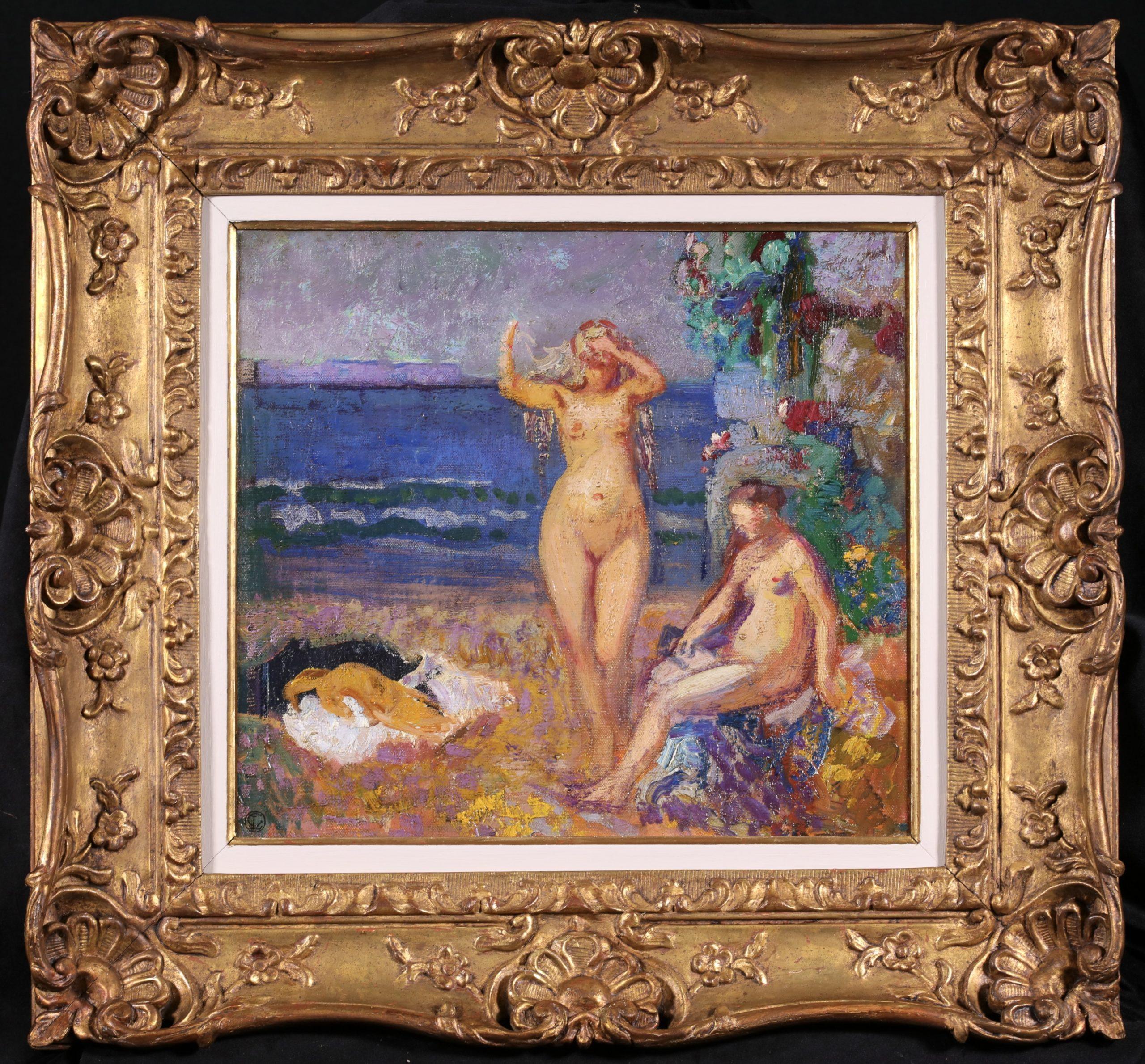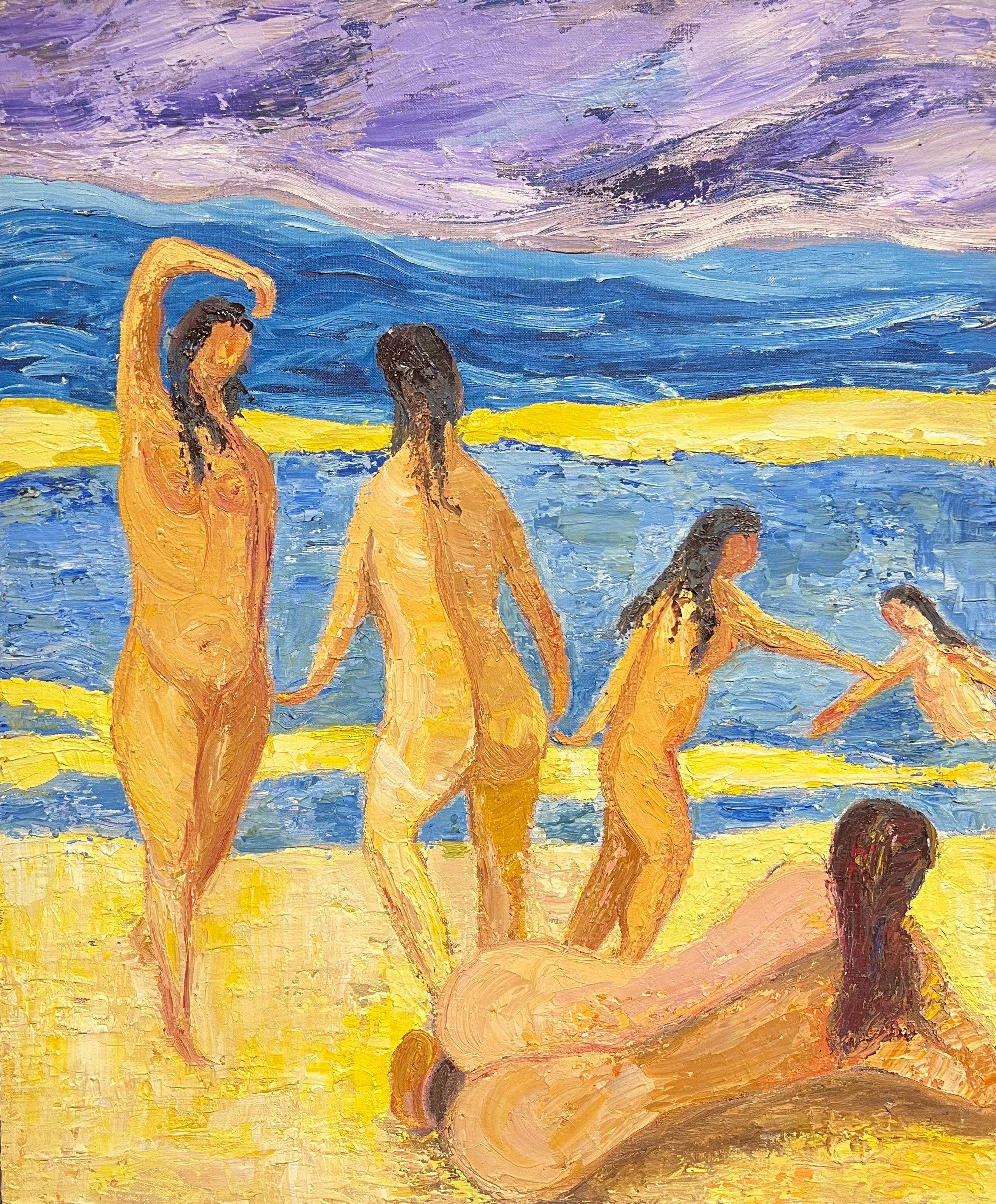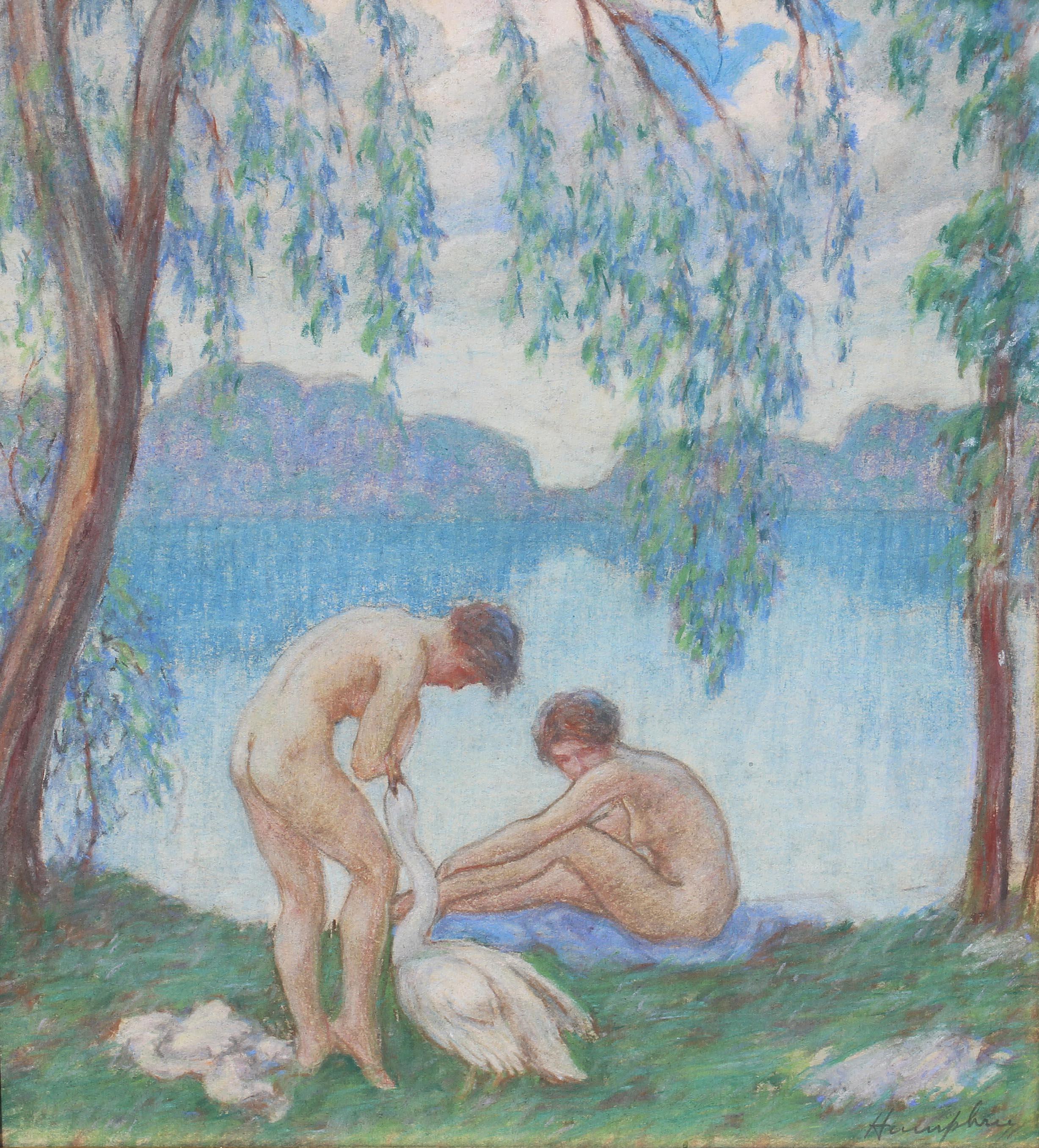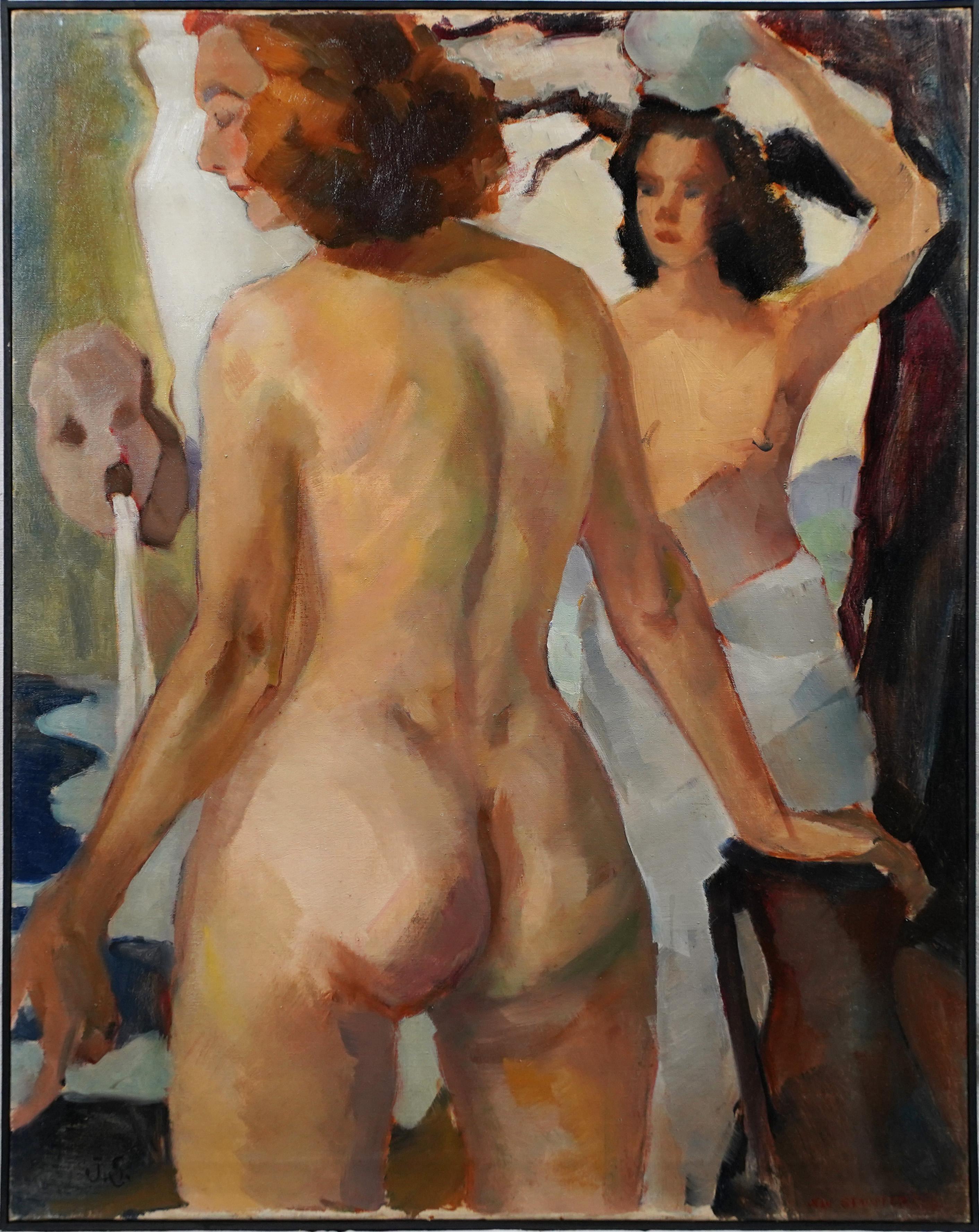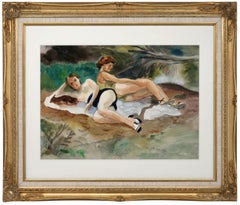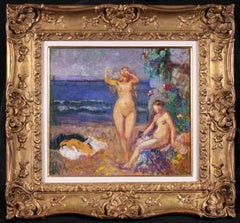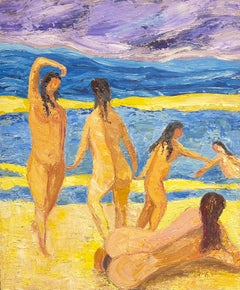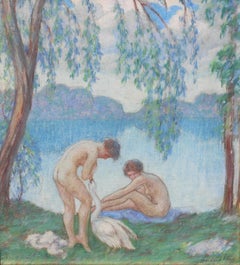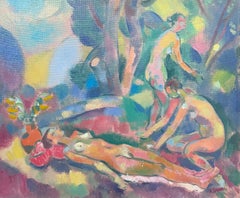Items Similar to Bathers, Oil on Canvas, 1914
Video Loading
Want more images or videos?
Request additional images or videos from the seller
1 of 13
Roger GrillonBathers, Oil on Canvas, 19141914
1914
$35,000
£26,317.61
€30,431.25
CA$49,394.66
A$53,595.70
CHF 28,431.52
MX$658,150.92
NOK 351,605.52
SEK 332,970.01
DKK 227,156.64
About the Item
Oil on canvas by Roger GRILLON (1881-1938), France, 1914. "Bathers". With frame: 114x94 cm - 44.9x37 inches ; without frame: 92x73cm - 36.2x28.75 inches. 30F format. Signed lower left "R. Grillon". Named and dated on the back of the frame "Baigneuses Mars-Juin 1914". Family provenance, Hôtel Drouot, June 26, 1967. Illustrated on the cover of the catalog.
This major work by Roger Grillon is dated March-May 1914. It is very interesting in several aspects. The theme of bathers is represented in the modern period. The productions of Cézanne and Renoir are very well known. Those of Cézanne predate this one by about ten years, this one can be compared to the work of Maurice Denis from the same period.
The work is distributed in two large horizontal planes separated by an intermediate plane.
The lower foreground shows four naked young women seated or lying on a sheet protecting them from the grass. Three of them shield their faces from the sun's rays piercing the trees. Their bodies pinked by the sun show rounded shapes in the canons of the time. They are defined by black outlines that make them pop out of the canvas for a stark contrast with the natural surroundings. They occupy almost the entire surface of the canvas. The title of the work, Baigneuses (Bathers), is therefore unequivocal. The sheet on which these young women lie is white like the bodies and reflects the same shadows. It is also defined by dark circles which make it, with the young women, the whole foreign to the natural environment in which it is located. At the bottom of the composition, the grass on which this set rests is represented by expected colors. To complete this will of the painter, on the right, the hat carelessly placed on the grass, completes the known and conventional world of 1914. Like a kind of border, limit. These are the only reminders to the society of the time. The elongated body of the young woman at the bottom occupies the entire width of the composition. It marks the stability on which this homogeneous whole rests. Two trees on either side of this group provide protection. It brings out positive feelings such as gentleness, confidence, serenity and abandonment.
The middle plane is represented by water of a deep blue, powerful, of impenetrable purity. A demarcation with the background plane.
With the focus on the young women in the foreground, the background plane is depicted in a blurred form similar to a photographic process. The unknown. The danger ? But also the dream. Only the colors give indications of its nature. And what colors! Gorgeous greens and blue! For a magical and mysterious effect.
This poetic and powerful painting offers a synthesis of the movements of the modern period which precedes it. It announces the neo-realist wave of the post-war period.
Maurice Roger Grillon, born in Poitiers on September 28, 1881 and died in Maule on June 19, 1938, was a French painter, illustrator and wood engraver. He is the son of Albert-Fulgence Grillon, painter and lithographer in Poitiers.
After a childhood spent in his father's lithography studio, in 1900 he came to follow the Beaux-Arts courses in Paris in Fernand Cormon's studio. There he became friend with Matisse and Marquet, and in 1904 began to send nudes and portraits to the Salon des Artistes Français, women in their boudoir, landscapes at dusk and still lifes dimmed in half-light, but he quickly gave up this salon, preferring to exhibit his work at the Indépendants and the Salon d'Automne. At the dawn of this century, Grillon felt the temptations of the Impressionism, and in a traditional, if not conventional, setting, placed the women à la Renoir, with vibrant flesh under the sun. Soon the impressionist liberties prevail, the blue shadows and the games of shimmering reflections gain his landscapes; he even confronted divisionism but did not abandon the down-to-earth realism that dominates his work, and from which he draws the deepest roots in southern nature. In 1926, the Parisian gallery Berthe Weill devoted a personal exhibition to him. He successively settled to paint near Albi, in Collioure, in Saint-Paul de Vence, then in Roussillon in Prades and in the Corbières, in Lagrasse, which became his chosen land. It illustrates with woodcuts or etchings works by Paul Morand, Montherlant, Mauriac, Delteil.
From 1939, Raymond Escholier organized a retrospective of his work at the Petit Palais in Paris (February-March 1939), presenting paintings, drawings, but also engravings. Indeed, Roger Grillon illustrated several works, such as Venus and Adonis by Shakespeare (1921, woodcut), The Child who took fear by Auguste Gilbert de Voisins (1926, etchings) or Perpignan by Joseph Delteil (1927 , etchings).
In 1940, Paris, André gallery, rue des Saint-Pères (with Jean Dufy, Lucien Génin, Marcel Dyf, Wilder, Zingg, Zendel).
In 1952, Marc Sandoz presented an important retrospective around Roger Grillon, bringing together eighty works (paintings, watercolours, drawings, illustrations). In October 1981 the Martin-Caille gallery (Paris) devotes a retrospective to him and an album in which the paintings of Lagrasse are the most numerous.
In 1988 the Paul Gauguin Center in Pont-Aven devoted an exhibition to him.
The museums of Algiers, Angers, Albi, Carcassonne, Céret, Fontenay-le-Comte, La Rochelle, Grenoble, Troyes, the Georges Pompidou National Museum of Modern Art and the Luxembourg Museum hold works by Roger Grillon.
- Creator:Roger Grillon (1881 - 1938, French)
- Creation Year:1914
- Dimensions:Height: 37.01 in (94 cm)Width: 44.89 in (114 cm)Depth: 1.97 in (5 cm)
- Medium:
- Movement & Style:
- Period:
- Condition:
- Gallery Location:Saint Amans des cots, FR
- Reference Number:1stDibs: LU1088215739052
About the Seller
5.0
Vetted Professional Seller
Every seller passes strict standards for authenticity and reliability
1stDibs seller since 2018
38 sales on 1stDibs
- ShippingRetrieving quote...Shipping from: Saint Amans des cots, France
- Return Policy
Authenticity Guarantee
In the unlikely event there’s an issue with an item’s authenticity, contact us within 1 year for a full refund. DetailsMoney-Back Guarantee
If your item is not as described, is damaged in transit, or does not arrive, contact us within 7 days for a full refund. Details24-Hour Cancellation
You have a 24-hour grace period in which to reconsider your purchase, with no questions asked.Vetted Professional Sellers
Our world-class sellers must adhere to strict standards for service and quality, maintaining the integrity of our listings.Price-Match Guarantee
If you find that a seller listed the same item for a lower price elsewhere, we’ll match it.Trusted Global Delivery
Our best-in-class carrier network provides specialized shipping options worldwide, including custom delivery.More From This Seller
View AllFernande Horovitz-Edwards, Bathers, Large Oil on Canvas, 1930s
Located in Saint Amans des cots, FR
Large Oil on Canvas by Fernande Horovitz-Edwards, France, 1930s - "Bathers". This large oil on canvas by Fernande Horovitz-Edwards, titled Bathers, dates from the 1930s and showcases...
Category
1930s Post-Impressionist Figurative Paintings
Materials
Canvas, Oil
Berthomme Saint-André, Before Bathing, 1926
By Louis Berthomme Saint-Andre
Located in Saint Amans des cots, FR
Watercolor by Louis BERTHOMME SAINT-ANDRE, France, 1926. Befor bathing. With frame: 74x63.5 cm - 29.1x25 inches ; without frame, just the watercolor: 50x36 cm - 19.7x14.2 inches. Si...
Category
1920s Art Deco Nude Drawings and Watercolors
Materials
Watercolor
Nude, Oil on Canvas by B.Robert, Ca. 1930
Located in Saint Amans des cots, FR
Oil on Canvas by B. Robert, France, circa 1930. This exquisite oil painting by B. Robert, created in France around 1930, captures the serene beauty of a young nude woman reclining. T...
Category
1930s Art Deco Nude Paintings
Materials
Canvas, Oil
Charles PICART LE DOUX, Model on Green Background, Oil on Isorel, 1949
By Charles Picart le Doux
Located in Saint Amans des cots, FR
Oil on isorel panel by Charles PICART LE DOUX (1881-1959), France, 1949. Model on green background. With frame: 97.5x76.5 cm - 38.4x30.1 inches ; without frame: 81x60cm - 31.9x23.6 i...
Category
1930s Post-Impressionist Nude Paintings
Materials
Oil
YVES DIEY The Nude, Oil on canvas, 1930s
By Yves Diey
Located in Saint Amans des cots, FR
Oil on canvas by Yves Dieÿ (1892-1984), France – The Nude. A striking oil on canvas by the renowned French artist Yves Dieÿ (1892-1984), depicting a sensual and elegant nude. This wo...
Category
1930s Art Deco Nude Paintings
Materials
Canvas, Oil
Oil on canvas, Naked woman lying in front of her mirror
By Robert Louis Raymond Duflos
Located in Saint Amans des cots, FR
Oil on canvas by Robert Louis Raymond DUFLOS (1898-1929), France, 1920s. Naked woman lying in front of her mirror. With frame: 95x61.5 cm -...
Category
1920s Art Deco Nude Paintings
Materials
Canvas, Oil
You May Also Like
Les Baigneuses - Neo-Impressionist Nudes in Landscape Oil by Georges Lemmen
By Georges Lemmen
Located in Marlow, Buckinghamshire
Signed oil on canvas nudes in landscape circa 1910 by Belgian neo-impressionist painter Georges Lemmen. The work depicts nude bathers on a sunny beach beside the sea.
Signature:
Signed lower left with the cachet of painter
Dimensions:
Framed: 23.5"x24.5"
Unframed: 14.5"x15.5"
Provenance:
Olivier Bertrand (expert on the painter) has confirmed the authenticity of this work
Georges Lemmen was the son of an architect and studied under Amédée Bourson at the academy in St Joost-ten-Node. He was invited in 1889 to join the Group of Twenty ( Cercle des XX) which had been launched in 1884 by Oscar Maus and had in the interim emerged as an influential force in Belgian artistic circles, not least by bringing to public and critical attention the work of such artists as Georges Seurat and Paul Signac. The Cercle des XX would be reborn in 1894 as La Libre Esthétique.
In the early days of the Cercle des XX, Lemmen espoused a pointilliste technique. His earlier painting was clearly influenced by the Neo-Impressionists; over time, however, his style became more subtle and nuanced - recalling, perhaps, that of his compatriot Van Rysselberghe, another Cercle des XX member. With the group's rebirth as the Libre Esthétique, Lemmen's work became more intimiste in character, most notably in his portraits, nudes and still-lifes, where the influence of Bonnard and Vuillard is unmistakable, as is that of Renoir, particularly after Lemmen's travels in the Midi in 1911. From this point onwards, he would go on to make a major contribution to the renewal of the graphic and decorative arts in terms of his input to the new 'free' aesthetic and to Art Nouveau. Although his draughtsmanship retained its essential purity and elegance of line, his painting became more fleshy, imprecise and sensual, his compositions governed less by technical considerations than by the urgent need to express his emotions.
Between 1889 and 1893, Lemmen exhibited at the Salon des Indépendants in Paris, aligning himself with the Neo-Impressionists. In 1893, Henry van de Velde invited him to participate in the Pour l'Art association that had been created in Antwerp. He travelled to the south of France in 1911. By this juncture, he had already exhibited solo on two occasions (in 1906 and 1908) at the Galerie Druet in Paris. A further solo exhibition in 1913, his first in Brussels, cemented Lemmen's reputation.
Museum and Gallery Holdings:
Bremen (Kunsthalle): Standing Nude Combing her Hair
Brussels (Mus. royaux des Beaux-Arts de Belgique): Children's Room (watercolour); Reading; Couture; Young Girl by the Sea...
Category
1910s Impressionist Nude Paintings
Materials
Oil, Canvas
French Post Impressionist Vibrant Large Oil Painting Nude Bathers on the Beach
Located in Cirencester, Gloucestershire
Nude Bathers
French School, circa 1975
oil on canvas, unframed
Canvas : 25.5 x 21.5 inches
inscribed verso
Provenance: private collection, Paris
Condition: very good condition
Descr...
Category
Mid-20th Century Post-Impressionist Nude Paintings
Materials
Canvas, Oil
Impressionist Painting Nude Bathers by David Humphrey
By David Humphrey
Located in Rochester, NY
Nude bathers, fine early 20th century impressionist painting by David Humphrey (American 1872-1950.) Pastel on paper.
Humphrey was born in Elkhorn, Wiscons...
Category
Early 20th Century Art Nouveau Figurative Paintings
Materials
Pastel
Large Russian Post-Impressionist Signed Oil Painting Nude Bathers in Woodland
Located in Cirencester, Gloucestershire
Alexander Khanin (Orenburg 1955)
signed oil on canvas, framed
framed: 23 x 27.5 inches
canvas: 21 x 25.5 inches
Inscribed verso dated 1988
Provenance: private collection, Paris
Cond...
Category
1990s Post-Impressionist Figurative Paintings
Materials
Oil, Canvas
Vintage Paris School Nude Female Bathers Double Sided Impressionist Oil Painting
Located in Buffalo, NY
Antique impressionist nude woman portrait oil painting. Oil on canvas. Framed.
Category
1950s Impressionist Nude Paintings
Materials
Canvas, Oil
$716 Sale Price
20% Off
Baigneuses en Bord de Rivière by Georges Manzana Pissarro - Nude painting
By Georges Henri Manzana Pissarro
Located in London, GB
*UK BUYERS WILL PAY AN ADDITIONAL 5% IMPORT DUTY ON TOP OF THE ABOVE PRICE
Baigneuses en Bord de Rivière by Georges Manzana Pissarro (1871-1961)
Oil on cardboard
98.2 x 79.4 cm (38...
Category
1910s Post-Impressionist Figurative Paintings
Materials
Oil, Cardboard
